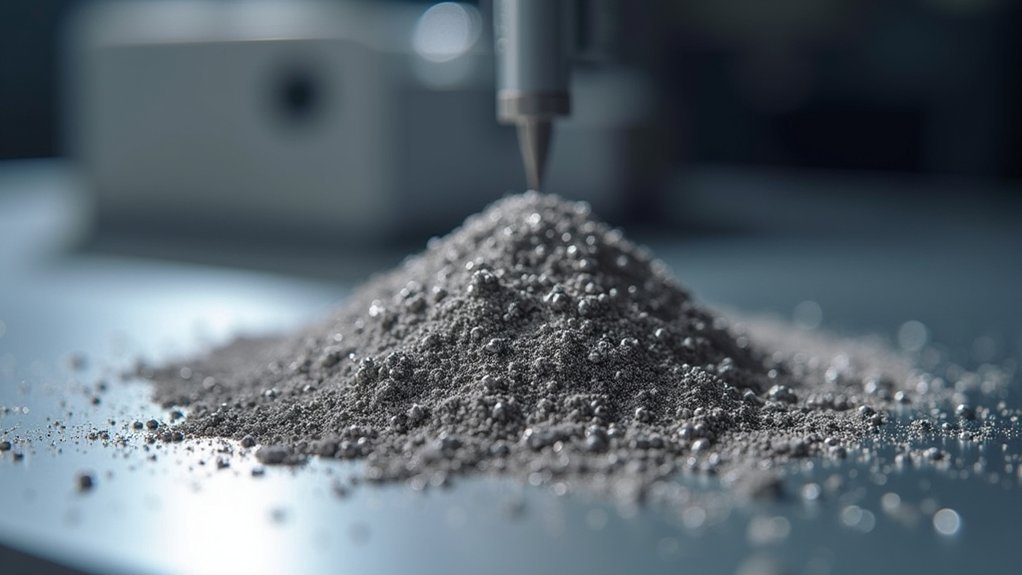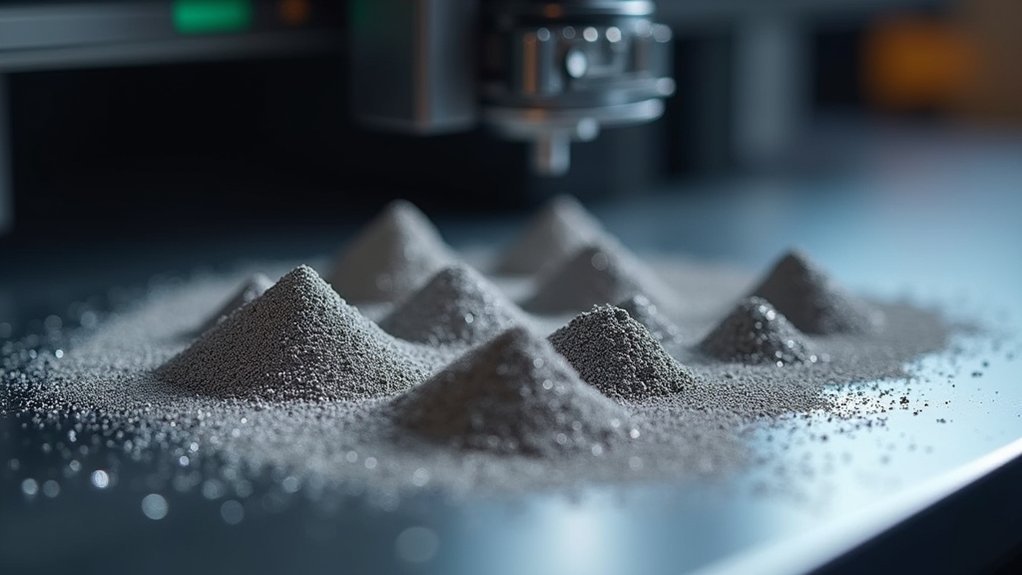You can achieve exceptional 3D printing results with specialized tool steel powders like EOS MaragingSteel MS1 and ToolSteel 1.2709, which deliver tensile strengths up to 2250 MPa. These cobalt-free, ultra-high strength alloys excel in demanding applications including aerospace components, cutting tools, forming dies, and injection molds. Popular grades like H13, A2, and D2 have been successfully adapted for additive manufacturing, offering superior wear resistance and fatigue performance. The thorough guide below reveals optimization strategies for your specific manufacturing requirements.
Understanding Tool Steel Powder Composition and Properties

Innovation in additive manufacturing has transformed tool steel powders into precision-engineered materials that deliver exceptional performance for demanding applications.
When you’re selecting tool steel powders for 3D printing, you’ll find compositions like EOS ToolSteel 1.2709 offer cobalt-free ultra-high strength formulations with moderate carbon content. These powders provide outstanding mechanical properties, including yield strength reaching 2000 MPa and tensile strength up to 2250 MPa.
EOS ToolSteel 1.2709 delivers cobalt-free ultra-high strength with yield strength reaching 2000 MPa for demanding 3D printing applications.
You’ll appreciate the excellent heat treatability these materials provide, allowing you to enhance hardness and strength post-printing.
The high strength characteristics, combined with fatigue resistance and dimensional stability, make these powders ideal for precision tooling applications. Their specialized chemistry guarantees consistent performance in additive manufacturing processes while maintaining the rigorous standards required for industrial tooling applications.
Types of Tool Steel Alloys Available for 3D Printing
You’ll find several high-performance steel compositions specifically engineered for additive manufacturing, each offering distinct advantages for different applications.
Popular tool steel grades like H13, A2, and D2 have been successfully adapted for 3D printing, while specialty alloys such as EOS MaragingSteel MS1 and ToolSteel 1.2709 deliver exceptional tensile strength reaching up to 2250 MPa.
These carefully formulated compositions combine high carbon content with precise alloying elements to guarantee you get the durability and performance characteristics needed for demanding tooling applications.
High-Performance Steel Compositions
When selecting tool steel powders for additive manufacturing, you’ll find several high-performance compositions that deliver exceptional mechanical properties for demanding applications.
These tool steels include EOS ToolSteel 1.2709, which offers outstanding fatigue strength for both cold and hot-working tools.
You’ll achieve impressive results with EOS MaragingSteel MS1, featuring 2250 MPa tensile strength and superior heat treatability.
Popular alloy compositions like D2, M2, H13, and MS1 provide exceptional wear resistance due to their high carbon content, making them ideal for cutting, stamping, and molding processes.
In metal 3D printing, these unique compositions withstand high temperatures while maintaining hardness, ensuring your intricate tooling applications perform reliably across various industries with consistent excellent mechanical performance.
Popular Tool Steel Grades
While numerous tool steel alloys have entered the 3D printing market, several grades have emerged as industry favorites due to their proven performance and reliability.
You’ll find EOS ToolSteel 1.2709 leading the pack with exceptional mechanical properties and fatigue strength, making it perfect for both cold and hot-working applications.
EOS MaragingSteel MS1 delivers impressive tensile strength up to 2250 MPa while remaining easily heat treatable through thermal age-hardening processes.
Traditional grades like D2, H13, and M2 have also found success in additive manufacturing, offering high carbon content that provides superior wear resistance and toughness.
These tool steel powders enable you to create complex geometries with intricate details that would challenge conventional machining methods.
EOS MaragingSteel MS1 Specifications and Performance

Excellence defines EOS MaragingSteel MS1, a cobalt-free alloy that adheres to the 1.2709 chemical composition standard and delivers exceptional performance in additive manufacturing applications.
Excellence characterizes this cobalt-free maraging steel alloy, meeting 1.2709 standards while delivering exceptional additive manufacturing performance.
This steel achieves an impressive 2250 MPa tensile strength, making it perfect for demanding aerospace components requiring superior mechanical properties in 3D printing applications.
You’ll benefit from its thermal age-hardening process, which enhances hardness and strength through heat treatment.
The metal excels in fatigue resistance, ensuring reliable performance under cyclic loading conditions.
Whether you’re developing cold or hot-working tools, this ultra-high strength steel provides outstanding durability.
Its cobalt-free composition eliminates material sourcing concerns while maintaining exceptional performance standards, making it ideal for critical aerospace applications where reliability can’t be compromised.
EOS ToolSteel 1.2709 Applications and Benefits
You’ll find EOS ToolSteel 1.2709 delivers exceptional performance for both cold and hot-working tool applications thanks to its cobalt-free ultra-high strength formulation.
This advanced material lets you create cutting tools, forming dies, and injection molds that withstand demanding manufacturing environments while maintaining superior wear resistance.
You can achieve tailored hardness levels through heat treatment, making it versatile enough for everything from precision cutting operations to high-temperature forming processes.
Cold and Hot-Working Tools
Manufacturing professionals who demand exceptional performance from their tooling applications will find EOS ToolSteel 1.2709 delivers unmatched reliability for both cold and hot-working environments. This cobalt-free ultra-high strength steel’s excellent mechanical properties make it ideal for demanding manufacturing scenarios where cutting tools must withstand extreme conditions.
| Application Type | Key Benefits |
|---|---|
| Cold-Working Tools | High hardness retention, superior fatigue resistance |
| Hot-Working Tools | Thermal stability, consistent performance at elevated temperatures |
| General Tooling | Heat treatable flexibility, reliable 3D printing quality |
You’ll achieve ideal results through heat treatment, allowing customization for specific requirements. The stable structure from carefully balanced alloying elements and moderate carbon content guarantees your tools maintain durability. Metal powders processed through 3D printing create consistent, high-quality tool components that meet rigorous industrial standards.
Cobalt-Free Ultra-High Strength
When precision and strength become non-negotiable requirements in your tooling applications, EOS ToolSteel 1.2709 delivers exceptional performance through its cobalt-free ultra-high strength formulation.
This tool steel reaches tensile strengths up to 2080 MPa while maintaining excellent mechanical properties that aerospace and automotive industries demand. You’ll benefit from its heat-treatable nature, allowing customization of hardness levels to match specific application requirements.
The stable structure supports both cold and hot-working operations.
- Unleash unmatched durability with cobalt-free ultra-high strength that won’t compromise on performance
- Achieve aerospace-grade reliability through superior mechanical properties and fatigue resistance
- Master complex tooling challenges with heat-treatable versatility for custom hardness profiles
- Dominate demanding applications where precision manufacturing meets unforgiving operational conditions
- Experience peace of mind knowing your tools deliver consistent results in critical automotive production
Metal 3D Printing Processes Compatible With Tool Steel Powders

Several metal 3D printing processes can effectively utilize tool steel powders, with Direct Metal Laser Sintering (DMLS) and Powder Bed Fusion leading the compatibility list.
You’ll find these processes excel at producing parts from EOS ToolSteel 1.2709 and EOS MaragingSteel MS1, delivering exceptional mechanical properties including tensile strengths reaching 2250 MPa.
When you’re selecting parameters, you’ll need controlled laser power and precise layer thickness to guarantee consistent quality.
The thermal age-hardening capability of these powders allows you to customize hardness and strength post-printing.
You’ll benefit from validated process data sheets that manufacturers provide, which help you achieve repeatable results and maintain production reliability.
These documented parameters eliminate guesswork, assuring your printed tool steel components meet demanding application requirements consistently.
Industrial Applications for 3D Printed Tool Steel Components
Across diverse manufacturing sectors, you’ll discover that 3D printed tool steel components revolutionize production workflows by delivering exceptional performance in tooling, dies, and molds.
Tool steel powders processed through Direct Metal Laser Sintering enable you to create complex geometries that weren’t possible with traditional manufacturing methods. The superior mechanical properties of these materials, combined with their heat treatability, make them ideal for demanding industrial applications across automotive, aerospace, and medical device sectors.
Direct Metal Laser Sintering transforms tool steel powders into complex geometries with superior mechanical properties for demanding industrial applications.
- Breakthrough innovation: Create intricate cooling channels in molds that dramatically improve cycle times
- Cost transformation: Eliminate expensive tooling setup costs for low-volume production runs
- Design freedom: Manufacture impossible geometries that optimize performance beyond conventional limits
- Speed advantage: Reduce lead times from months to weeks for critical tooling components
- Competitive edge: Meet specific industry needs with customized solutions that outperform traditional alternatives
Comparing Tool Steel to Other Metal Printing Materials
Although stainless steels dominate much of the metal 3D printing landscape, tool steels deliver superior performance when your applications demand exceptional hardness, wear resistance, and high-temperature strength.
While stainless steels like 17-4 PH offer wear and corrosion resistance for general industrial use, tool steels such as EOS ToolSteel 1.2709 and MaragingSteel MS1 achieve tensile strengths up to 2250 MPa.
You’ll find tool steels excel where mechanical properties matter most – cutting tools, molds, and high-stress components.
Unlike many metal printing materials that work well as-printed, tool steels require specific heat treatment to optimize hardness.
However, 3D printing enables you to create complex geometries in tool steels that traditional machining can’t achieve, opening new possibilities for custom tooling solutions.
Quality Control and Testing Standards for Tool Steel Powders
The complex geometries and demanding applications that make tool steel 3D printing so valuable require rigorous quality control standards to guarantee consistent performance.
You’ll receive inspection certificates (EN 10204, Type 3.1) with every batch of tool steel powders, verifying compliance with industry standards. Each powder undergoes thorough testing for chemical composition and mechanical properties like tensile strength and yield strength.
Quality control measures you can rely on include:
- Particle size distribution monitoring – maintaining ideal flow and printability
- Morphology analysis – assuring consistent powder characteristics
- Chemical composition verification – meeting exact alloy specifications
- Mechanical property validation – confirming fatigue strength performance
- Material test reports (EN 10204, Type 2.2) – documenting compliance for demanding applications
These standardized testing processes guarantee your tool steel powders deliver predictable results every time.
Selecting the Right Tool Steel Powder for Your Manufacturing Needs
When choosing tool steel powder for your 3D printing project, you’ll need to match material properties with your specific application requirements.
Consider EOS ToolSteel 1.2709 if you’re developing cobalt-free solutions requiring exceptional fatigue strength for cold and hot-working tools.
For high-performance manufacturing needs demanding maximum strength, EOS MaragingSteel MS1 delivers tensile strength up to 2250 MPa with easy heat treatment capabilities.
Evaluate your project’s mechanical properties requirements carefully.
Standard tool steel powders achieve tensile strength reaching 2080 MPa and yield strength up to 2000 MPa.
Your metal printing success depends on selecting powders with validated processes that guarantee consistent properties through optimized laser power and layer thickness parameters for your specific 3D printing applications.
Frequently Asked Questions
Can You 3D Print Tool Steel?
You can 3D print tool steel using specialized metal powders like EOS ToolSteel 1.2709 and MaragingSteel MS1. These powders work with Direct Metal Laser Sintering, creating complex geometries you can’t achieve through traditional machining.
How Do You 3D Print Steel?
You’ll use Direct Metal Laser Sintering (DMLS) to 3D print steel. The process fuses metal powder layers with high-powered lasers, requiring ideal parameters like proper laser power and layer thickness for consistent results.
How to Make Metal Powder for 3D Printing?
You’ll create metal powder through gas atomization by dispersing molten metal into fine droplets that solidify into spherical particles. You’ll then sieve and classify them to achieve uniform size distributions for ideal 3D printing performance.
Which Metal Powders Is Commonly Used in Powder Bed Fusion 3D Printing Processes?
You’ll commonly use stainless steel, titanium alloys, aluminum alloys, tool steels like maraging steel, nickel-based superalloys, and cobalt-chrome powders in powder bed fusion processes for their excellent mechanical properties.





Leave a Reply